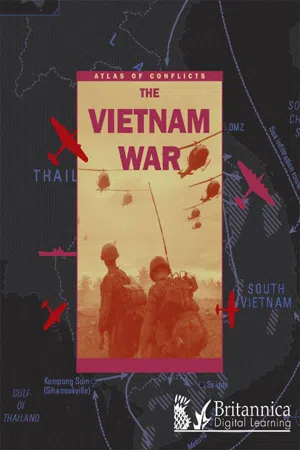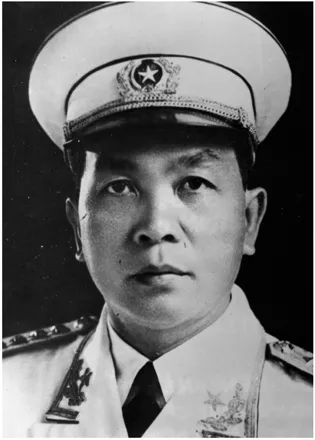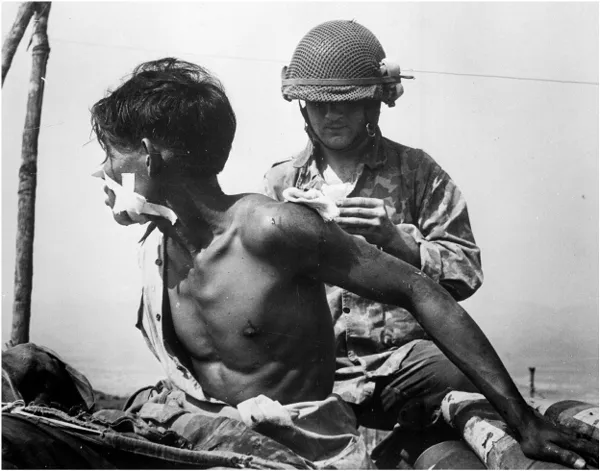
eBook - ePub
The Vietnam War
Reg Grant, Britannica Digital Learning
This is a test
- English
- ePUB (mobile friendly)
- Available on iOS & Android
eBook - ePub
The Vietnam War
Reg Grant, Britannica Digital Learning
Book details
Book preview
Table of contents
Citations
About This Book
The Vietnam War explores the long and costly civil war pitting South Vietnamese and U.S. forces against communist guerrillas and North Vietnamese troops.
Frequently asked questions
At the moment all of our mobile-responsive ePub books are available to download via the app. Most of our PDFs are also available to download and we're working on making the final remaining ones downloadable now. Learn more here.
Both plans give you full access to the library and all of Perlego’s features. The only differences are the price and subscription period: With the annual plan you’ll save around 30% compared to 12 months on the monthly plan.
We are an online textbook subscription service, where you can get access to an entire online library for less than the price of a single book per month. With over 1 million books across 1000+ topics, we’ve got you covered! Learn more here.
Look out for the read-aloud symbol on your next book to see if you can listen to it. The read-aloud tool reads text aloud for you, highlighting the text as it is being read. You can pause it, speed it up and slow it down. Learn more here.
Yes, you can access The Vietnam War by Reg Grant, Britannica Digital Learning in PDF and/or ePUB format, as well as other popular books in History & Vietnam War. We have over one million books available in our catalogue for you to explore.
Information
CHAPTER 1
THE FIRST INDOCHINA WAR

Japanese troops move into Vietnam in July 1941, beginning their four-year occupation of the country. At the time, Vietnam was part of French Indochina, a French colony.
Vietnam is a communist country in southeast Asia with a population of about 80 million. Its recorded history stretches back more than 2,000 years. In the second half of the nineteenth century, at a time when European countries were extending their rule over much of Asia and Africa, the French made Vietnam part of French Indochina. This French colony also included Vietnam’s neighbors, Cambodia and Laos.
From the start, Vietnamese nationalists opposed French rule, but the French colonial authorities harshly repressed all opposition. In the early decades of the twentieth century, many nationalists took refuge abroad. One such nationalist was Ho Chi Minh, the son of a Vietnamese official. In 1920, while living in France, Ho became a communist. From then on, he dedicated his life to two goals: achieving national independence for Vietnam and establishing a communist society in which private ownership of industry and land would be abolished.
The French remained firmly in control of Indochina until World War II (1939–45). Early in the war, Germany invaded and occupied France. As a result, France was in no position to aid its colonists in Indochina when they came under pressure from Japan, an ally of Germany in the war and a rising power in Asia. In 1941, the French colonial authorities were forced to allow Japanese troops to occupy Indochina. Although the Japanese left the French officially in control, they effectively ruled the colony.
In the same year, Ho Chi Minh and other Vietnamese nationalists founded a guerrilla organization to fight both the Japanese and the French. They called it the Vietnam Doc Lap Dong Minh Hoi (“League for the Independence of Vietnam”), or Viet Minh for short. The leaders of the Viet Minh, including Ho and the organization’s chief military commander, Vo Nguyen Giap, were communists. As the name of the guerrillas suggests, however, they appealed above all to the Vietnamese desire for national independence.

In the early 1950s, French Indochina bordered an area of Asia that was largely under communist rule. The United States considered Indochina to be in the front line of its fight against the spread of communism.
During World War II, the Viet Minh received support from the United States, which had been at war with Japan since December of 1941. Ho’s guerrillas fought the Japanese with increasing success and won control of large areas of northern Vietnam. In March 1945, the Japanese abolished French rule in Indochina, but the following August Japan surrendered to the United States and its allies. This surrender left a power vacuum in Vietnam that the Viet Minh were quick to exploit. On September 2, 1945, in the northern city of Hanoi, Ho declared Vietnam independent under a Viet Minh government. In the southern city of Saigon, however, which was occupied by British troops, the French regained control.

General Vo Nguyen Giap commanded the Viet Minh forces during the First Indochina War. This picture of Giap is from 1966, when he was North Vietnam’s Minister of Defense.
At first, the two sides reached a compromise. In March 1946, the Viet Minh and the French agreed that Vietnam would be a “Free State” within the French empire. But the following November, fighting broke out between the French and the Viet Minh, first in the northern port city of Haiphong and then in Hanoi. The Viet Minh army withdrew from these cities to the countryside, where they launched a guerrilla war against the French.

Viet Minh guerrillas cross an improvised bridge during their struggle against the French in 1953. Traveling almost entirely on foot in Vietnam’s rough terrain, the Viet Minh were formidable fighters.
A NEW FIGHT Until 1949, it seemed the French would be able to contain the guerrillas. In that year, however, communists led by Mao Zedong took control of Vietnam’s huge neighbor to the north, China. Supplied with arms and equipment by the Chinese communists, the Viet Minh were able to take the initiative. Much of Vietnam is mountainous and covered in thick jungle. It was an ideal place for the guerrillas, who could hide from view and then ambush the more heavily armed French troops. In 1951, the Viet Minh launched a major offensive. Although the French were able to defend the densely populated area of the Red River Delta in the north, the Viet Minh took control of many French outposts in rural areas.
France lacked the resources to sustain a war in Indochina over a long period, and it soon became dependent on U.S. support. In general, the United States favored independence for countries under European colonial rule. By 1947, however, the Cold War had begun. In this struggle for dominance between the United States and the communist Soviet Union, the United States sought to stop the spread of communism, which it considered to be a global threat. After the communist takeover of China in 1949, the United States became worried about further communist expansion in Asia. When communist North Korea invaded South Korea in 1950, U.S. and United Nations (UN) troops were sent in to resist the invasion. At the same time, the United States also provided money and arms to the French to fight the Viet Minh.
By the end of 1953, France’s position in Vietnam was becoming desperate. The military strength of the Viet Minh had grown, and they had also gained widespread support among a people eager to be free of colonial rule. The French had set up a government under a traditional Vietnamese ruler, Emperor Bao Dai, but it attracted little support.

Under French rule, Vietnam was divided into three parts: Tonkin, Annam, and Cochin China. In 1954, the Viet Minh dominated most of Tonkin outside the major cities, as well as part of Annam and much of Cochin China.

A French doctor treats a Vietnamese soldier during the siege of Dien Bien Phu in 1954. Thousands of anticommunist Vietnamese fought alongside the French against the Viet Minh.
Seeking to regain the initiative, French commanders decided to establish a powerful base at Dien Bien Phu, a remote site in northern Vietnam close to the border with Laos. The commanders hoped the base would help block the Viet Minh supply lines bringing men and arms into Vietnam and prevent an expected Viet Minh attack on Laos. Seeing an opportunity to inflict a decisive defeat on the French, the Viet Minh assembled powerful infantry forces around Dien Bien Phu and hauled artillery up mountainsides around the French base. In March 1954, the guerrillas launched their attack. The French garrison, which consisted chiefly of elite parachute battalions, resisted fiercely. But they were surrounded and outnumbered, and they could only receive supplies by air.

French paratroopers float to the ground in Dien Bien Phu. The base was shelled by Viet Minh artillery positioned in the surrounding mountains.
France’s only hope of avoiding a humiliating defeat was to appeal to the United States. French and U.S. military commanders devised a plan for a massive aerial bombardment by U.S. aircraft to destroy the Viet Minh forces besieging the base at Dien Bien Phu. U.S. president Dwight D. Eisenhower, however, rejected the idea of involving U.S. forces directly in support of the French.

Vietnamese communist leader Ho Chi Minh was known as “Uncle Ho,” but he was ruthless in his pursuit of a united, communist Vietnam.
DEFEAT AT DIEN BIEN PHU On May 8, 1954, the Viet Minh finally overran the French forces at Dien Bien Phu. On the same day, a peace conference opened in Geneva, Switzerland, to discuss an end to the war. The following July, a peace agreement called the Geneva Accords granted Vietnam, Laos, and Cambodia independence from France. But Vietnam was divided in two, with Ho and the Viet Minh taking control north of the 17th parallel and Emperor Bao Dai ruling south of the parallel.

The Democratic Republic of Vietnam (North Vietnam) was separated from the Republic of Vietnam (South Vietnam) by a demilitarized zone (DMZ) along the 17th parallel.
According to the Geneva Accords, this division would be temporary. Vietnam was to be reunited in two years’ time, after democratic elections were held to choose a government for the whole country. No such elections, however, were ever held. In the north, Ho established the Democratic Republic of Vietnam, which was usually called North Vietnam. Ruled by the communist Vietnamese Workers’ Party, North Vietnam became a communist state like the Soviet Union, China, North Korea, and various countries in Eastern Europe. In the south, the Republic of Vietnam was established. Known as South Vietnam, it was first ruled by Emperor Bao Dai. He was soon replaced by Ngo Dinh Diem, a tough leader who had the backing of the United States.
After the Geneva Accords, about 900,000 Vietnamese, believing there was no place for them i...
Table of contents
- Cover Page
- Title Page
- Copyright Page
- Contents
- 1. The First Indochina War
- 2. More U.S. Involvement
- 3. Search and Destroy: 1965–1967
- 4. A Turning Point: 1968
- 5. Vietnamization: 1969–1971
- 6. Easter Offensive to Christmas Bombing
- 7. Communism Triumphs
- 8. Aftermath
- Profiles of Military and Political Leaders
- Statistics
- Time Line
- Glossary
- Further Information
- Index